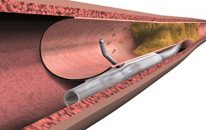Transcatheter aortic valve replacement (TAVR) is much less invasive than surgical replacement. This is associated with a substantial reduction in bleeding events (up to 60% less). However, clinically relevant bleeding is still present in one every four patients who undergo TAVR, which is associated with morbidity and mortality. Cases of bleeding are not uniform: they may…
Risk of Thrombosis and Bleeding with Peripheral Artery Disease and Concomitants
Peripheral artery disease (PAD) is no longer a systemic manifestation of atherosclerosis. In fact, 2 in 3 people with PAD have concomitant heart disease, and 1 in 3 people has concomitant PAD. To understand the real dimension of this problem, we should know that PAD patients have 60% more risk of acute myocardial infarction…
Common Femoral PCI Becomes a Valid Alternative
Gentileza del Dr. Carlos Fava. The common femoral artery has always been treated with surgery. Thanks to the development of new generation stents and the advancement of percutaneous intervention, common femoral lesions are currently being treated with PCI. However, data on the safety of PCI vs. surgery, remain unavailable. The TECCO is multicenter study, randomized…
How to standardize frailty in aortic stenosis patients
Frailty is the patient’s diminished capacity to recover after pathological or iatrogenic processes. It has a fundamental role when considering valve replacement, be it surgical (SAVR) or transcatheter (TAVR). This was clearly observed in the PARTNER I and Core-Valve Pivotal trials, which showed that despite a 95% technical success, 2 in 5 patients showed poor quality…
Incomplete Revascularization Is Associated with Mortality in TAVR
Courtesy of Dr. Carlos Fava. TAVR has proven to be beneficial for inoperable and high-risk patients, as well as for intermediate-risk patients. However, while many comorbidities have been analyzed, the presence, severity, and impact of coronary disease has not been well studied yet. This study analyzed 1270 patients who underwent TAVR. They presented >50% lesions in a major epicardial…
Different Techniques for the Improvement of Outcomes in Intermittent Claudication
Peripheral vascular diseases affect over 20% of the population and can affect up to 30% of people with cardiovascular risk factors. The most important treatment points include modification of risk factors, exercise, optimal medical treatment, and timely revascularization. Given its lower risk of peri-procedural complications (when compared to surgery), endovascular therapy is generally the first…
Valve Deterioration after TAVI Is Rare and Should Not Prevent Advancement to Younger Populations
Durability ─or better yet, lack of deterioration─ is still a matter of debate when considering transcatheter aortic valve intervention (TAVI), especially now that it is being explored as a real alternative for younger patients. A recently published meta-analysis offers more evidence and suggests TAVI deterioration is mostly rare within the first 5 years. According to…
ProEducar’s Course José Gabay Successfully Completed
The eight month of this year saw a scientific event of utmost importance to the community of young interventional cardiologists in Latin America: the José Gabay course. The meeting, which took place at Buenos Aires Hilton Hotel, gathered more than 140 fellows eager to update their medical knowledge on this area of expertise. The event…
SOLACI CACI 2017 | Re-entry approach to CTO
Read articles on the main presentations of the third day of SOLACI-CACI 2017 Congress. See the presentation by Dr. Luiz Fernando Ybarra, entitled “Re-entry approach to CTO”. We are interested in your opinion. Please, leave your comments, thoughts, questions, etc., below. They will be most welcome.
SOLACI CACI 2017 | Is the PCI risk higher in patients with severe Aortic Stenosis? How can we reduce the risk?
Read articles on the main presentations of the third day of SOLACI-CACI 2017 Congress. See the presentation by Dr. Daniel Weilenmann, entitled “Is the PCI risk higher in patients with severe Aortic Stenosis? How can we reduce the risk?“. We are interested in your opinion. Please, leave your comments, thoughts, questions, etc., below. They will be most welcome.









